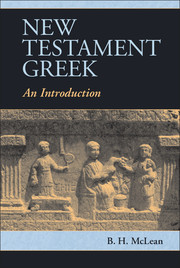Book contents
- Frontmatter
- Contents
- Abbreviations
- Introduction
- 1. Alphabet and Pronunciation
- 2. Writing Greek Letters, Accents, Diacritical Marks, and Punctuation
- 3. Present and Future Active Indicative, Present Active Indicative of the Verb “to be,” and Particles
- 4. Contract Verbs, Present and Future Active Indicative, and Future Indicative of Liquid Verbs
- 5. Second Declension, the Definite Article, and Prepositions
- 6. First Declension and the Definite Article
- 7. Adjectives, Demonstrative Pronouns, and Comparison
- 8. Personal Pronouns, Relative Pronouns, and Reflexive Pronouns
- 9. First Aorist Active Indicative
- 10. Verbal Roots, Principal Parts, and Second Aorist Active Indicative
- 11. Present Middle and Passive Indicative, Future Middle Indicative, and Future Indicative of the Verb “to be”
- 12. Imperfect Active Indicative and Imperfect of the Verb “to be”
- 13. Imperfect Middle and Passive Indicative and First and Second Aorist Middle Indicative
- 14. Third Declension Nouns and Adjectives: Part 1
- 15. Third Declension Nouns and Adjectives: Part 2
- 16. Perfect and Pluperfect Active, Middle, and Passive Indicative
- 17. Aorist Passive and Future Passive Indicative
- 18. Present and Aorist Participles
- 19. Aorist Passive Participle, Perfect Participle, Adverbial Participles, Genitive Absolute, and Periphrastic Constructions
- 20. The Athematic Conjugation (-μι verbs): Part 1 – The Indicative Mood
- 21. The Athematic Conjugation (-μι verbs): Part 2 – δείκνυμι, ϕημί, and Participles
- 22. Subjunctive Mood and Conditional Sentences
- 23. The Infinitive
- 24. Imperative Mood
- Appendix 1. Principal Parts of the Greek Verb
- Appendix 2. Summary of Paradigms
- Summary of Vocabulary to Be Memorized
- Subject Index
- Index of Greek Words Discussed
- Lexicon of Greek Words in Texts for Translation
- References
12. - Imperfect Active Indicative and Imperfect of the Verb “to be”
Published online by Cambridge University Press: 05 June 2012
- Frontmatter
- Contents
- Abbreviations
- Introduction
- 1. Alphabet and Pronunciation
- 2. Writing Greek Letters, Accents, Diacritical Marks, and Punctuation
- 3. Present and Future Active Indicative, Present Active Indicative of the Verb “to be,” and Particles
- 4. Contract Verbs, Present and Future Active Indicative, and Future Indicative of Liquid Verbs
- 5. Second Declension, the Definite Article, and Prepositions
- 6. First Declension and the Definite Article
- 7. Adjectives, Demonstrative Pronouns, and Comparison
- 8. Personal Pronouns, Relative Pronouns, and Reflexive Pronouns
- 9. First Aorist Active Indicative
- 10. Verbal Roots, Principal Parts, and Second Aorist Active Indicative
- 11. Present Middle and Passive Indicative, Future Middle Indicative, and Future Indicative of the Verb “to be”
- 12. Imperfect Active Indicative and Imperfect of the Verb “to be”
- 13. Imperfect Middle and Passive Indicative and First and Second Aorist Middle Indicative
- 14. Third Declension Nouns and Adjectives: Part 1
- 15. Third Declension Nouns and Adjectives: Part 2
- 16. Perfect and Pluperfect Active, Middle, and Passive Indicative
- 17. Aorist Passive and Future Passive Indicative
- 18. Present and Aorist Participles
- 19. Aorist Passive Participle, Perfect Participle, Adverbial Participles, Genitive Absolute, and Periphrastic Constructions
- 20. The Athematic Conjugation (-μι verbs): Part 1 – The Indicative Mood
- 21. The Athematic Conjugation (-μι verbs): Part 2 – δείκνυμι, ϕημί, and Participles
- 22. Subjunctive Mood and Conditional Sentences
- 23. The Infinitive
- 24. Imperative Mood
- Appendix 1. Principal Parts of the Greek Verb
- Appendix 2. Summary of Paradigms
- Summary of Vocabulary to Be Memorized
- Subject Index
- Index of Greek Words Discussed
- Lexicon of Greek Words in Texts for Translation
- References
Summary
Aspect of the Imperfect
The aspect of the imperfect tense is imperfective. In other words, the action is understood to be in progress, without reference to its final completion. Such an action may infer attempting, continuing, setting about, or beginning an action, depending on the context. As such, different English expressions are be required to translate the imperfect tense in different passages. For example, an imperfect tense might be translated by such English phrases as:
was (do)ing
was trying to (do)
began (doing)
used to (do)
Uses of the Imperfect
In contrast to the aorist tense, the imperfect tense is usually employed selectively with a more nuanced range of connotations. When you encounter a verb in the imperfect tense, you should treat it with special care and try to determine whether a more nuanced meaning is implied, on the basis of context. Here are some possibilities:
- Type
- Chapter
- Information
- New Testament GreekAn Introduction, pp. 108 - 112Publisher: Cambridge University PressPrint publication year: 2011



